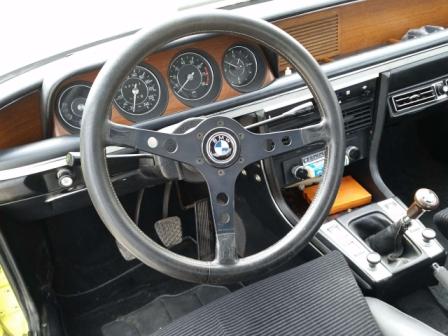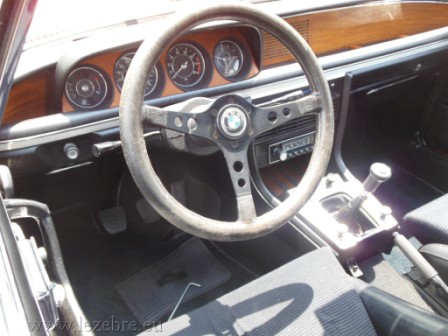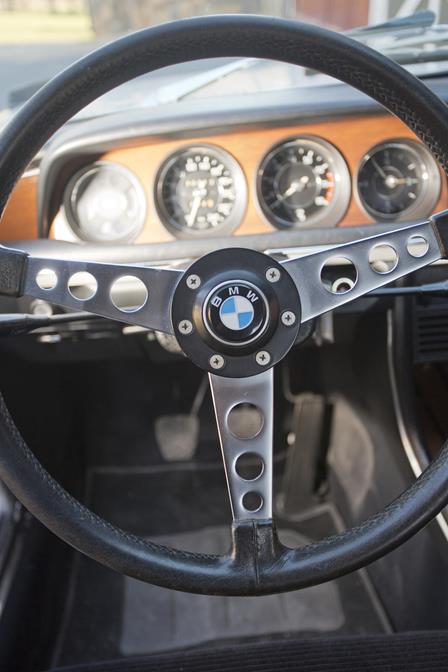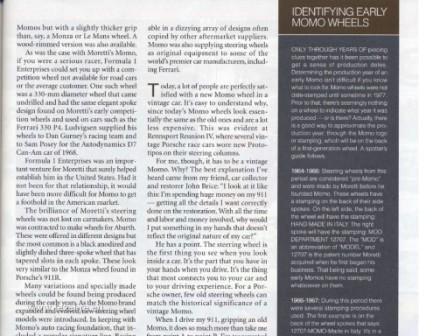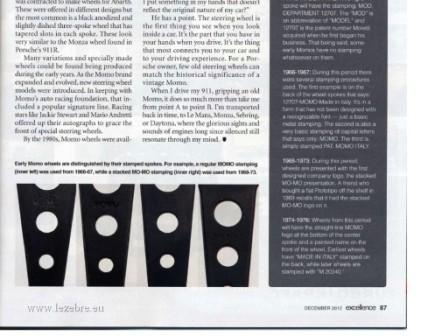


Steering wheel
This page is trying to to sort which wheel was on which CSL. Feedback is welcome in case you find mistakes.
Carburated CSLs
Early Carb CSL
Later carbs
Injected CSLs up to approx 2275030
-
Injected CSLs from approx 2275030
-
RHD CSLs
-
All Alpina steering wheels were made by Momo. - It was the summer of 2006. My 911 hot rod project had stalled and was collecting dust in the back of the shop where the work was being done. Or, more accurately, wasn’t being done. Bored, I dug out a vintage Momo steering wheel I found the previous year. I had always been intrigued by the wheel. It was a flat-spoked version that looked just like the classic Prototipo — except it had a little “1” inside two circles engraved at the bottom of the center spoke. With a beautiful brown patina adorning its leather cover and the aura of Porsche’s racing past, the wheel seemed to be begging to tell a story. All I had were unanswered questions. What did the “1” stand for? How old was it? Why wasn’t it available any longer? The more I held the wheel in my hands, the more intrigued I became. I simply had to try to unravel its mystery. In doing so, I would begin a quest to discover everything I could about old Momo steering wheels. The Momo story begins with founder Gianpiero Moretti. Moretti, who died after a long illness in January 2012 was obsessed with motor racing. Before he became a professional driver, it would be his innovation and ingenuity as a businessman that would forever connect him to the sport he loved so much. Growing up in Milan, Moretti idolized Italian drivers and the teams they drove for. One was Scuderia Sant Ambroeus, founded in 1951 by Franco Martinengo, Olympic bobsledder Alberto della Beffa, Alessandro Zafferri and legendary coachbuilder Elio Zagato. In 1963, after becoming disenchanted with the steering wheel in his Fiat, Moretti decided to take matters in his own hands, literally. He made his very first steering wheel in a garage in Milan owned by Giorgio Pianta, a driver for Sant Ambroeus who had become his friend. Moretti took the drawing he'd done of the wheel's design along with a plate of aluminum he had purchased to the mechanics at Pianta's garage. The wheel was cut by hand from an aluminum plate, its spokes riveted to a U-shaped metal circle to form the outer rim. It was then covered with laminated maho¬gany by a carpenter in Galerie Lombardia (Milan). Soon after that, Moretti decided that a leather-covered wheel would be easier to hold. (developed his concept for a leather-covered wheel). A revolutionary idea redefined what a steering wheel should be for a race-car: His wheel had a small diameter and a thicker leather-covered grip that would be ergonomic and comfortable, giving a driver better control of his car. The following year, 1964, with Moretti’s new wheel firmly in his grasp, John Surtees guided a Ferrari 158 to the Formula One World Championship. The next several years were a whirlwind of successes. As suddenly as it appeared, Moretti’s steering wheel became a must-have for drivers. He continued to supply steering wheels to Ferrari and, by 1966, Momo was born. In a very short period, Moretti went from being a young race fan to being the owner of an internationally connected company whose products were sought after by the racing departments of the most respected carmakers in the world. One of those would be a company whose name would grace his most recognized race car — Porsche. The 911R, 906, 907, most configurations of the 908, and the 910 would all use Moretti’s steering wheels. On April 20, 1969, Ferdinand Piëch completed a most improbable feat when representatives of the Commission Sport¬ive Internationale would look on in disbelief at a spectacular sight: 25 brand-new 917s lined up at the Porsche factory. Mounted inside each and everyone was a Momo competition model Prototipo. Momo is something of an enigma — information from the company’s early years is just about nonexistent. Virtually no records of company activities exist today, except in the memories of the people who were there. The name Momo — properly, MOMO — is an acronym using the combination of the first two letters of Moretti and Monza. It’s that historic track near the city with the same name that can be found etched on the spokes of some of Moretti’s earliest, most beautiful, and most revered steering wheels. During those days, the focus of Momo’s steering wheel production was on racing, but the majority was intended for international export to the automotive aftermarket. “The first F1 wheel we made for John Surtees, who won the world championship, we called ‘Prototipo,’” says Marco Cattaneo, owner of Momo Design. Cat¬taneo was Moretti’s partner and CEO during the early years. It was a great tribute to the steering wheel in that championship-winning car when Moretti created a version for the mass market. The competition-model Momo steering wheels made available to racing teams were slightly different than the wheels produced in greater numbers. First, there was the version made for Formula 1 cars. And Momo made dish-spoked Prototipos and Monzas, some of which were supplied un¬drilled, with leather pads on all three spokes. These extremely rare Momo steering wheels are what you will find on many of the 1968-73 racing Porsches. Some of the first models made available for sale to the general public by Momo were the Le Mans, Monza, Elite, Indy, Daytona, Sebring, and Monte Carlo. While most had leather grips, the Indy and Day¬tona were wood-rimmed. All were hand made and had the same classic spoke design. Without a doubt, the most well-known and popular Momo steering wheel among Porsche fans is the Prototipo — a wheel developed later in Momo’s first year. The very first group of Momo steering wheels have characteristics that set them apart from later wheels. I refer to these early wheels as first-generation. The vast majority were flat-spoked and available with silver or black spokes. A small number of them were also produced in a dished-spoke configuration. Both versions incorporated that beautiful, classic design: Three tapered spokes of anticordal aluminum, each simply adorned with three circular holes gradually increasing in size as they make their way to the inside. They have the product name engraved on the center spoke. Sizes included 320, 350, 360, 370, and 380 millimeters in diameter. The spoke thickness is four millimeters. The 380-mm spoke design is fundamentally different from the smaller sizes and is easy to see with a side by side comparison; the spokes have been lengthened and widened for strength but have the same four-millimeter thickness. Momo’s Le Mans wheel was offered as a less-expensive option and is the only wheel made with a black vinyl covering held together with white thread in a distinctive, long cross-stitch pattern. The Elite and Sebring used a similar but shorter cross-stitch pattern in black thread. The Monza, Monte Carlo, and Prototipo all had more complex, double-horizontal stitching with white thread. These early Momo wheels were hand-crafted by an individual artisan who would use whatever leather was available to him, taking great care to adhere to quality standards set forth by Moretti. It is clear that there was inconsistency with the grain of leather used on these wheels — you will occasionally see some variety. Sometime after 1973, an important design evolution took place at Momo. This marked the beginning of the second-generation Momo steering wheels. Produc¬tion numbers increased dramatically, and the wheels changed. The most notable difference is the treatment of the name designation on the wheel. Starting during this period, the name of the wheel would be painted on the front instead of etched. The Momo logo itself was designed by an Italian graphic designer by the name of Bai in 1967 and was originally configured as two rows of letters stacked on top of each other. The logo was redesigned during this period to four letters in a single line, but Bai’s chosen font remained. The logo on most second-generation Momos was used on the face of the wheel instead of the back, where you would find it on first-generation wheels. The hand-stitched leather covering is arguably the most beautiful feature of an old Momo. Meticulously crafted with a leather tool called a skiver, the bottom seam will sometimes be almost invisible. A good indicator of an early wheel would be a leather seam at the bottom, just to the left (and sometimes right) of the center spoke. The later second-generation wheels have a leather seam at the bottom dead center. To my knowledge, all first-generation Momos have an off-center seam. Modern-day Momo Prototipos have the seam in the center, use a pebbled-surface leather and the name “prototipo” has a rectangle painted around it — black on silver spokes and white on black spokes. So what about my mysterious “1” wheel? Just by chance, I found an advertisement in a Road & Track magazine from 1967. The ad just about knocked me over when I saw it. The steering wheel within the ad was made by Moretti for the company Formula 1 Enterprises and was called “The Real Wheel.” Formula 1 Enterprises was founded by Karl Ludvigsen and Martin Siskind in 1967. Besides steering wheels, they offered an array of high-end racing products — Sebring mirrors, on-board fire extinguishing equipment, racing safety equipment, and more. Ludvigsen, an automotive journalist and Excellence contributor, says his previous job as General Motors overseas operations press relations chief didn’t do enough to absorb his interest in automobiles. With Formula 1 Enterprises, he’d established an exciting business venture that would satisfy him on two fronts — auto racing and marketing. In 1966, Ludvigsen was the New York representative for Ferrari Club of America and, through the club became good friends with Siskind. Siskind had managed to make connections Eugenio Dragoni, who at the time was manager of the Ferrari racing team. Dragoni also owned a cosmetics company in Italy and was keen to promote his products in the U.S. “Martin Siskind saw an opportunity there, so he and Dragoni discussed the idea of importing some equipment that was related to the Ferrari racing cars evolved,” says Ludvigsen. “That’s when we thought about the steering wheel, which of course was made by Gianpiero Moretti, the Momo wheel. It wasn’t really known as the Momo wheel at the time — we just knew Moretti made these wheels. The steering wheel was a key product.” Ludvigsen and Siskind made arrangements with Moretti to import his wheel, which included traveling to Italy. “We decided to call it the Formula 1 Real Wheel and he agreed to put our little number 1 logo on it, and that made a very characterful presentation,” explains Ludvigsen. The steering wheels that Moretti made for Formula 1 Enterprises reflected the palette he created for his Momo brand. You could buy a Prototipo-style wheel with silver or black spokes in the diameters offered by Momo. Or you could choose a “Real Wheel” that was offered with black or silver spokes, minus the spoke pads in a 380-mm diameter. The “Real Wheel” proved to be the company’s best seller and gave buyers a wheel similar to other non-Prototipo-style Momos but with a slightly thicker grip than, say, a Monza or Le Mans wheel. A wood-rimmed version was also available. As was the case with Moretti’s Momo, if you were a serious racer, Formula 1 Enterprises could set you up with a competition wheel not available for road cars or the average customer. One such wheel was a 330-mm diameter wheel that came undrilled and had the same elegant spoke design found on Moretti’s early competition wheels and used on cars such as the Ferrari 330 P4. Ludvigsen supplied his wheels to Dan Gurney’s racing team and to Sam Posey for the Autodynamics D7 Can-Am car of 1968. Formula 1 Enterprises was an important venture for Moretti that surely helped establish him in the United States. Had it not been for that relationship, it would have been more difficult for Momo to get a foothold in the American market. The brilliance of Moretti’s steering wheels was not lost on carmakers. Momo was contracted to make wheels for Abarth. These were offered in different designs but the most common is a black anodized and slightly dished three-spoke wheel that has tapered slots in each spoke. These look very similar to the Momo Monza wheel found in Porsche’s 911R. Many variations and specially made wheels could be found being produced during the early years. And as the Momo brand expanded and evolved, new steering wheel models were introduced. In keeping with Momo’s auto racing foundation, that included a popular signature line. Racing stars like Jackie Stewart and Mario Andretti offered up their autograph to grace the front of special steering wheels. By the 1980s, Momo wheels were available in a dizzying array of designs often copied by other aftermarket suppliers. Momo was also supplying steering wheels as original equipment to some of the world’s premier car manufacturers, including Ferrari to Porsche. Today, a lot of people are perfectly satisfied with a new Momo wheel in a vintage car. It’s easy to understand why, since today’s Momo wheels look essentially the same as the old ones and are a lot less expensive. This was evident at Rennsport Reunion IV, where several vintage Porsche race cars wore new Proto¬tipos on their steering columns. For me, though, it has to be a vintage Momo. Why? The best explanation I’ve heard came from my friend, car collector, and restorer John Brice: “I look at it like this. I’m spending huge money on my 911 — getting all the details I want correctly done on the restoration. With all the time and labor and money involved, why would I put something in my hands that doesn’t reflect the original nature of my car?” He has a point. The steering wheel is the first thing you see when you look inside a car. It’s the part that you have in your hands when you drive. It’s the thing that most connects you to your car and your driving experience. For a Porsche owner, there are few vintage steering wheels with an equal historical significance as a vintage Momo wheel. When I drive my 911 gripping an old Momo, it does so much more than take me from point A to point B. I’m transported back in time, to Le Mans, Monza, Sebring, or Daytona where the glorious sights and sounds of engines long since silenced still resonate through my mind. SIDEBAR Identifying early Momo wheels Only through years of piecing clues has it been possible to get a sense of production dates. Determining the production year of an early Momo isn’t difficult if you know what to look for. Momo wheels were not date-stamped until sometime in 1977. Prior to that, there’s nothing on a wheel to indicate what year it was produced — or is there? Actually, there is. The best way to get a good approximation is through the Momo logo or stamping, which will be on the back of a first-generation wheel. A spotter’s guide follows. 1964-1966: The very earliest Momos have stampings on both sides on the back of the side spokes. The back of the wheel on the left side will have the stamping: HAND MADE IN ITALY. The right side spoke will have the stamping: MOD. DEPARTMENT 12707. The “MOD” is an abbreviation of ‘model’ and 12707 is the patent number Moretti acquired when he first began his business. That being said, some early Momos that have no stamping whatsoever on them. 1966-1967: During this period there were several stamping examples that were used. The first example is on the back of the wheel spokes that says: 12707-MOMO-Made in Italy. It’s in a form that has not been designed with a recognizable font — just a basic metal stamping. The second is a very simple stamping of capital letters that only says: MOMO in a basic metal stamping. The third is PAT. MOMO ITALY, in another basic stamping. 1968-1973: During this period, wheels are presented with the first designed company logo with the stacked MO-MO presentation. A friend who told me he bought a flat Prototipo off the shelf in 1969 told me it had the stacked MO-MO logo on it. 1974-1976: Wheels from this period will have the straight-line MOMO logo at the bottom of the center spoke and a painted name on the front of the wheel. The earliest wheels have “MADE IN ITALY” stamped on the back, while later wheels are stamped with “M 20340.”
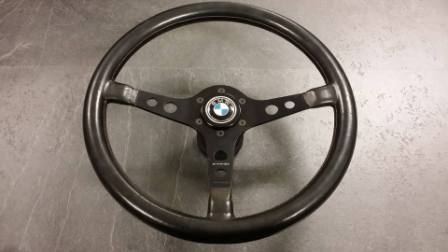
Momo Prototipo s - 38cm - stock in the early CSL's.
A sales brochure, shows two different carb
CSLs (Inka M-SE 1836 and Golf M-AH 1076). The interior-shot is from the
Inka. But the wheel-photo is from Jochen Neerpash's "Dienst Wagen/company
car" in Golf. Both cars are carb CSLs and have the black Alpina steering
wheel. The Golf has the "normal" Alpina 7x14 rims. So far, so good.
However, in the earlier CSL sales Brochure, where only one car appear
(the Inka M-SE 1836), there is another steering wheel on the
interior-photo. Namely, a non Alpina one in black satin with three holes
(instead of two for the Alpina one). The rims, on that Inka, are the
earlier Alpina split ones in black.
Most of the carbs were, most likely, equipped (from factory) with the black Alpina steering wheel. At least up to VIN 2212442 (?)
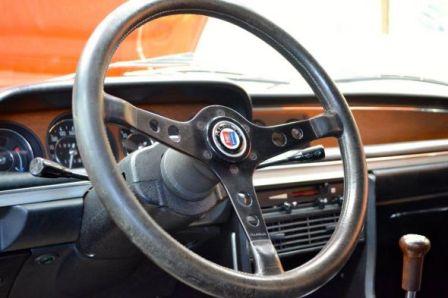
Above: Alpina wheel on a genuine CSL Alpina
2211724

Momo Prototipo s - optional for all E9's up to 1974.
The very first RHD (2285001 in Ceylon) had an Alpina style steering
wheel in alu. Next car, 2285002 had the "normal" Petri one. 2285004 had
the big 2800CS one. As a grand finale in the "CSL steering wheel saga",
the BMW UK press car (CSL with reg no NUC 20L) had ...surprise, surprise
- the Alpina steering wheel in Black satin!
Credit / Thank You / Reference:
http://www.e9coupe.com/forum/threads/early-csl-questions-petri-alpina-scheel.12259/
Henric
Hans Voertelboer
Marc Morrissey (MoMo article).


